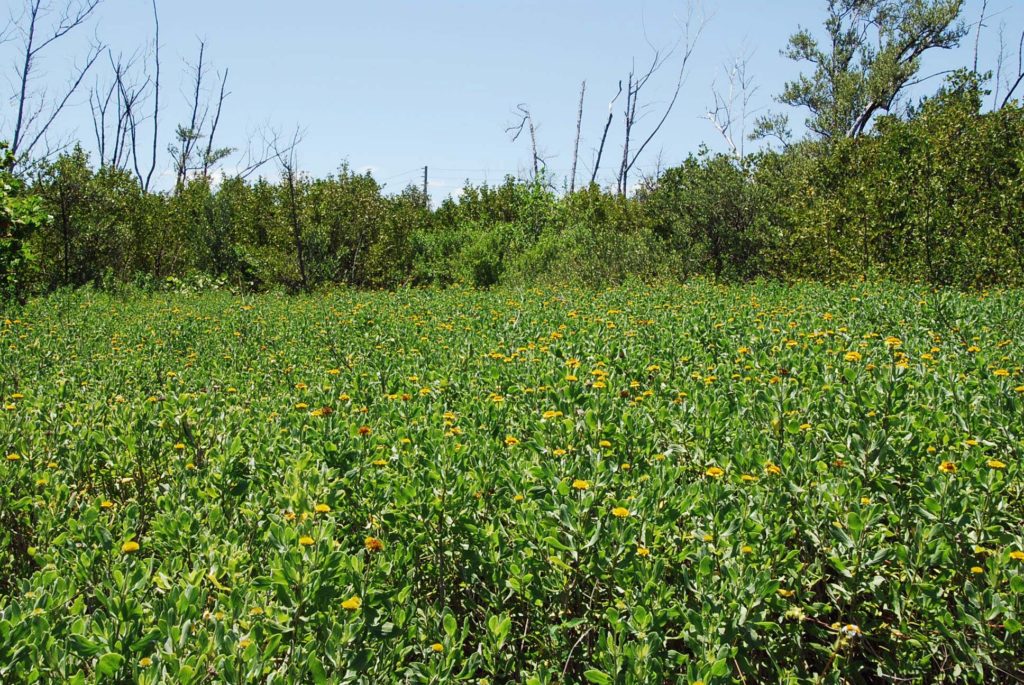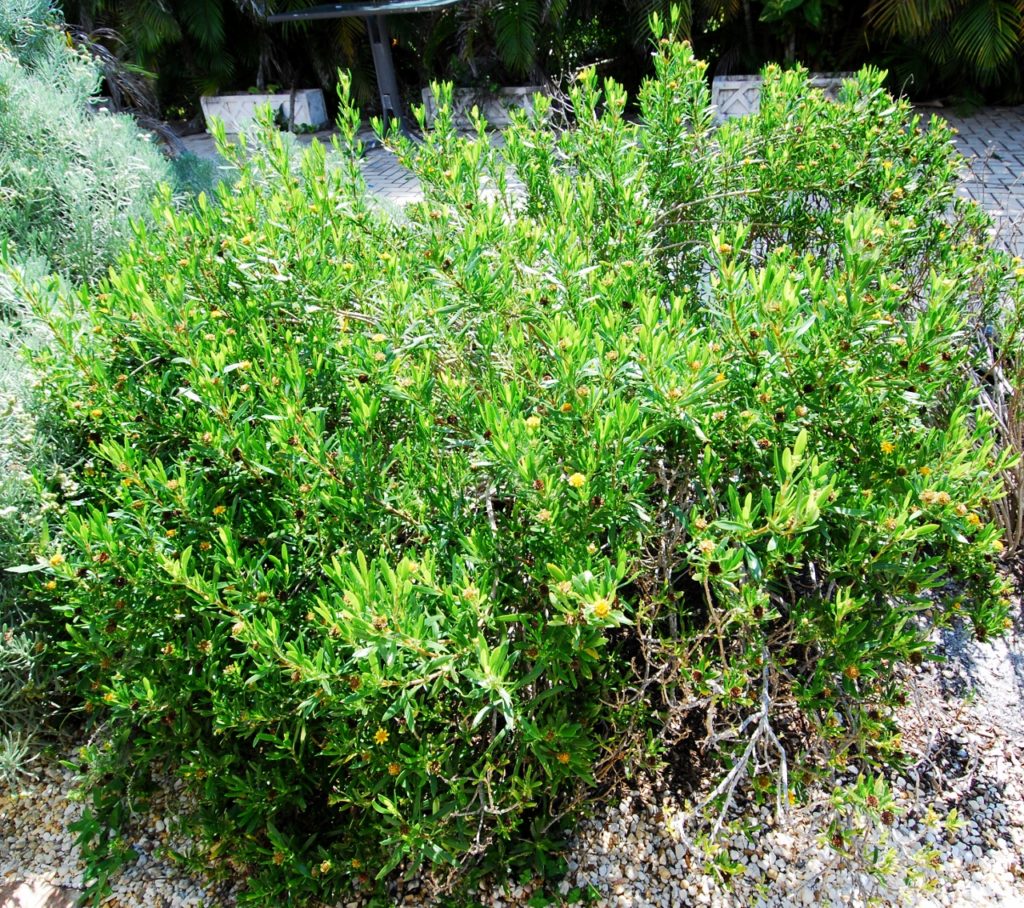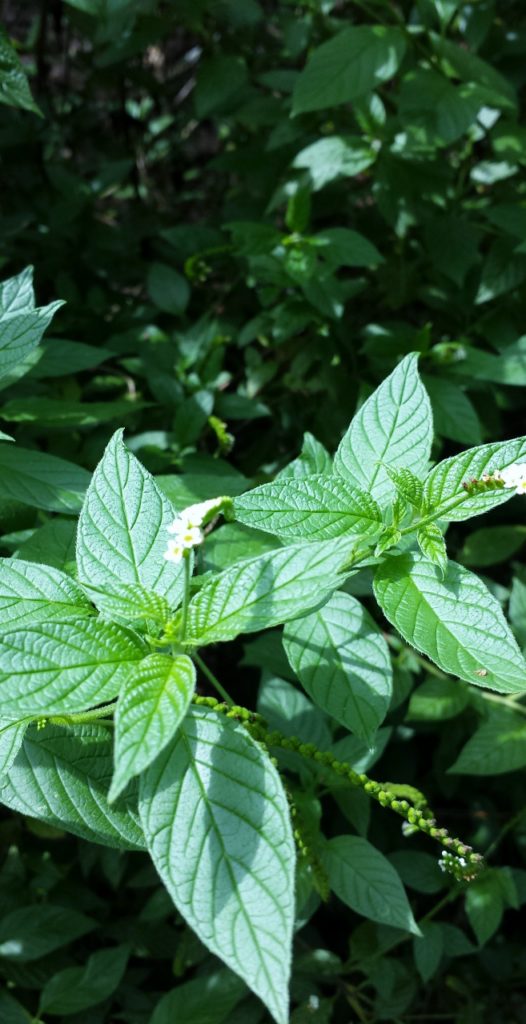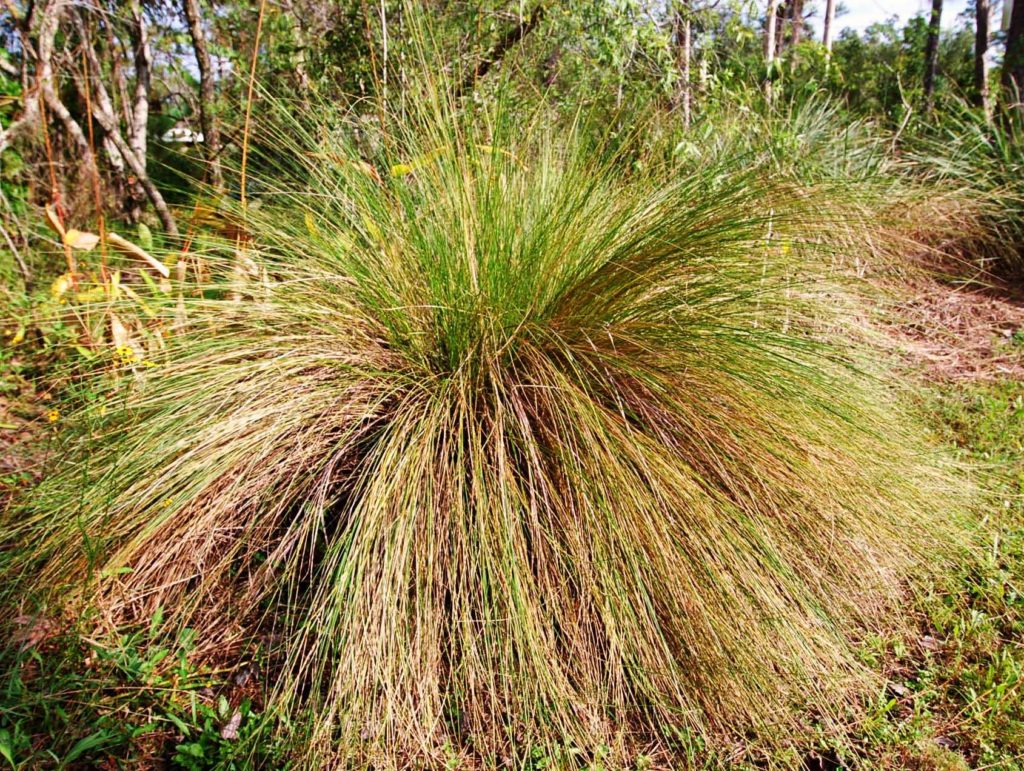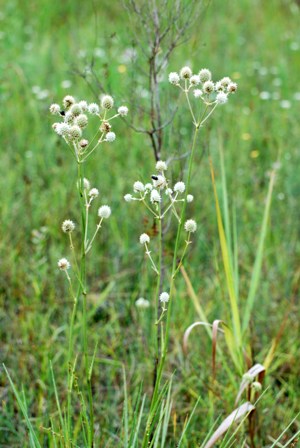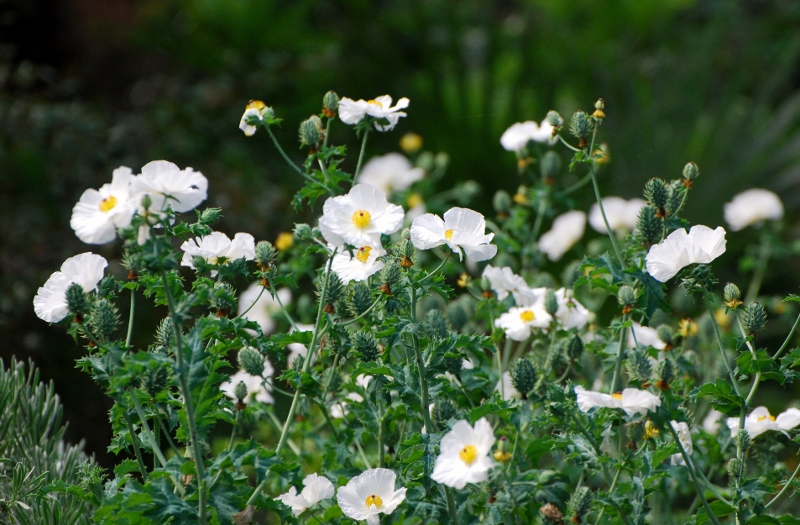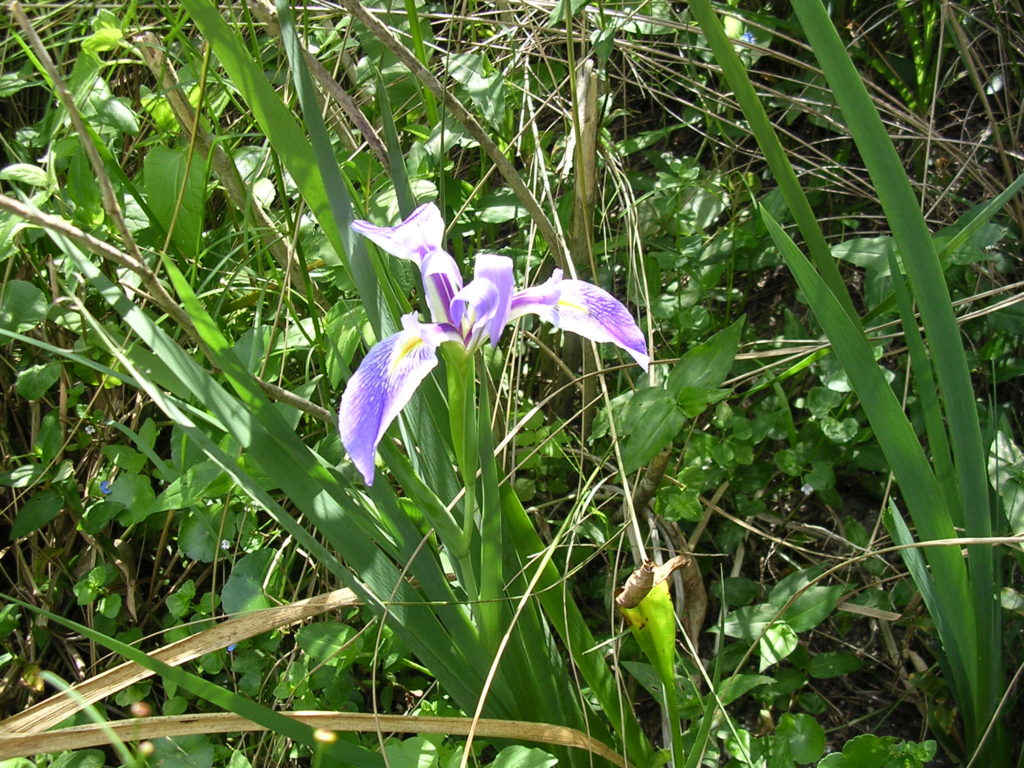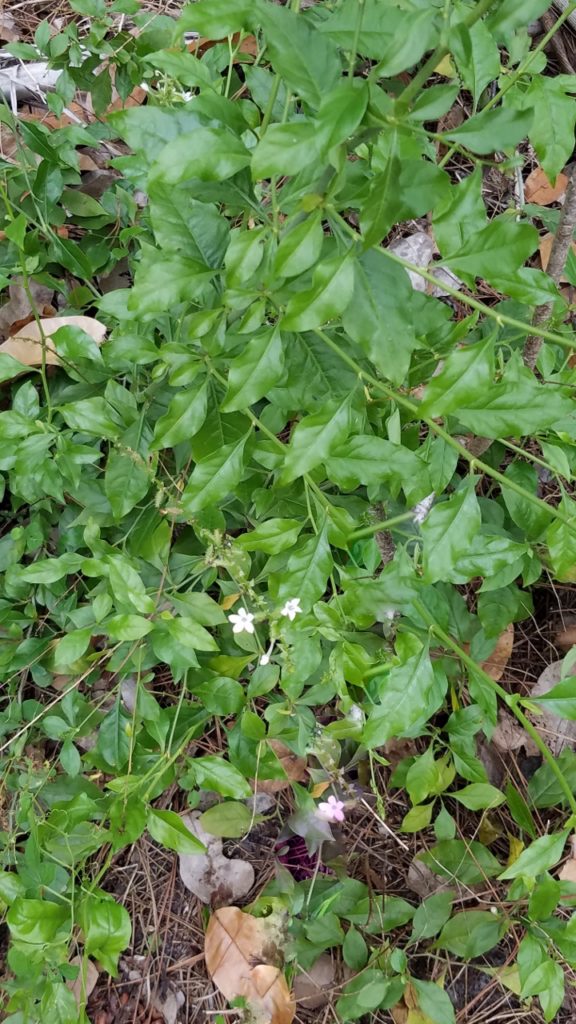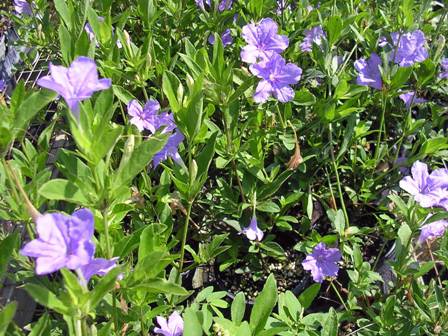Silver Sea-Oxeye-Daisy
Borrichia frutescens
Silver Sea-Oxeye-Daisy Is commonly found in salty environments from Maryland through the Florida Keys and west to Texas. It grows along the mangrove or saltmarsh fringe and on dune backs containing some organic matter.
Another similar plant, the Green Sea-Oxeye-Daisy is found mainly in South Florida. Click here. This plant is bushy and doesn’t sucker much, while the Silver Sea Oxeye suckers everywhere, even ten feet away.
This quality makes the silver form suited to boxed in areas where you want a full planting. I have used it in planters, along the intracoastal waterway and other sites with cement surrounding them.
This is also an edible plant, Click for more info. It is a bit bitter, yet it may be fun to try a small serving to see how you like it.
The silver leaves, two to three foot height, yellow flowers and ability to fill in a dry, sunny spot make this a great groundcover. Butterflies visit the flowers and birds, including painted buntings, eat the tiny seeds. The flower heads are a bit spiny, so don’t plant where you may brush up against it.
Various insects eat the seeds, foliage and cause galls within the stems. This makes it a source of insects for many bird species. The damage is usually not noticeable and should be tolerated.
For a mass planting in a low site, especially if it is saline, this is a great choice. Just give it its own space.
Click for more info, and here.
Green Sea-Oxeye-Daisy
Borrichia arborescens
Green Sea-Oxeye-Daisy is native from Biscayne National Park down through the Florida Keys. It is naturally found near salt marshes where it grows from commonly three, yet up to five feet tall.
Both the green and silver Sea-Oxeye-Daisy have leaves that can be eaten raw, yet are not tasty. Click for more info. Still, it is nice to know they are not poisonous if eaten in moderation.
Butterflies, bees and other pollinators visit the flowers. Donna and I have observed painted buntings eating the seeds of the silver species up in Jacksonville during the summer.
Green Sea-Oxeye-Daisy grows in a large clump that doesn’t run off the way the silver species does. It fills with yellow flowers throughout the spring and summer and has succulent leaves. This makes a great background plant for a sunny butterfly garden.
Plant with Scorpiontail, Silver Sea-Oxeye-Daisy, Sea Lavender, Chapman’s Cassia and Chapman’s Goldenrod, Key Lily, Coontie, Salvia, Giant Leather fern, Seaside Goldenrod and Beach Elder. Many lower species of wildflowers can be planted below. Sunshine Mimosa, Beach Verbena, Dune Sunflower, Twinflower, Pineland Petunia, Seaside Joyweed and Spiderwort are just a few.
click for more info.
Scorpion Tail
Heliotropium angiospermum
Scorpion Tail is a member of the Borage family which is known for producing butterfly and bee attracting flowers. It is found in most of Florida up to Volusia County and southern Texas. Older plants may become unattractive.
It does well during drought if there is some organic matter in the soil to hold moisture. This is also tolerant of moderate amounts of salt air and water when growing back of the dunes.
If you want lots of butterflies and bees in a less visible portion of the backyard, then try this great nectar producer that will bloom almost all year long. The plants can be three feet tall and six feet across, yet when you pull one up at the end of its one to two year life, you will clear a large area with one pull. Just wait a few weeks and seedlings will fill the site again.
The tiny, fragrant white flowers are on scorpioid cymes. This is a scorpion like tail with flowers on the upper surface. These are followed by small nutlets that may be eaten by seed eating birds like sparrows and buntings. Sparrows have been observed eating the seeds of other members of the Borage family:Click here.
Once you have Scorpion Tail, it will come back from seed for many years. Fortunately it doesn’t come up everywhere and can be managed. Plant in a butterfly garden with Chapman’s Cassia, Firebush, Bloodberry, Key’s Thoroughwort, Wild Plumbago, Yellowtop, Sea-Oxeye-Daisy, Salvia, Pineland Croton, Frostweed, Partridge Pea and Prickly Poppy.
Click for more info, and here, and here.
Sand Cordgrass
Spartina bakeri
Sand Cordgrass is a perennial, three foot tall clumping grass that is naturally found along the edges of brackish and freshwater marshes and lakes. It needs full sun and can tolerate dry soils as well as wet. It does not survive in permanently standing water, yet can tolerate one to two weeks of flooding.
The narrow leaves bend gracefully and make great specimens or can be grouped into a mass. It stays as a clump and won’t run off. Song birds eat the seeds and waterfowl hide among the leaves.
Try mixing this native grass with other wetland species along the upper edge of a lake. Golden Canna, Prairie Iris, Muhly Grass, Buttonbush, Virginia Willow, Red Maple, Bald and Pond Cypress, Leather Fern, Wax Myrtle, Fakahatchee Grass, Duck Potato and Salt Bush are good companions.
Scatter clumps in a pineland theme blended with Saw Palmetto and other shrubs and wildflowers. This is also a great soil binder that stops erosion. Plant in a V shaped mass with the open end upland where rain water pours into a lake to stop gullies from being formed in this high energy zone.
Cut the plants back to six inches in late winter to remove old leaves. Young growth will soon replace the stubble and gallinules, mottled ducks and other shore birds will use the cover to nest in.
Click for more info, and Here.
Red Salvia
Salvia coccinea
Red Salvia is also known as Tropical Sage,Texas Sage, Blood Sage, Hummingbird Sage, Scarlet Salvia, yet not Scarlet Sage which is from Brazil. Although Red Salvia is listed as an annual, it will live for at least five years if watered during prolonged drought, fertilized occasionally and cut back when full of dead heads.
Red salvia grows to two feet tall or more and is infrequently found along the coast and within inland hammocks. There is some debate as to whether it is native; I feel there is a good chance that it is.
It is tolerant of salt air back of the dune but not salt water flooding. I have found it naturally along the eastern edge of lake Okeechobee under an old live oak. Since there were Coontie there too, I wonder if it was a survivor of an old Indian site.
Seedlings come up easily around the plant, especially the pink form. Plant about two feet apart and make sure they stay where you want them or they will crowd out other plants. In fact, scattered seedlings look weedy and should be removed from a manicured front yard planting. Funny how Coreopsis always looks good no matter where it comes up yet Salvia doesn’t.
Butterflies and hummingbirds visit the flowers. Try some in a pot near the house. And many birds eat the seeds, including buntings that like the young, soft seeds. Seed eating insects attract warblers and other insect eaters.
Salvia is tolerant of full sun to moderate shade, yet will look poor if kept in full sun during a long period of drought. This is a good choice for pineland shade.
Naturally occurring colors include red, pink and white. Pink and white are recessive traits. Pink tends to become more prevalent as its genes increase within the population. We provide just red or a mix of all three colors as multiple seedlings.
This plant can be mixed with many types of clumping wildflowers like Gaillardia, Porterweed, Grasses, Horsemint, Yellowtop, Blue Curles, Beach Verbena, Seaside Goldenrod, Pineland Petunia, white flowered Mexican Poppy, Giant Ironweed and Dune Sunflower.
Click here for more info.
Rattlesnake Master
Eryngium yuccifolium
Rattlesnake Master is also called Button Snakeroot and Button Rattlesnakemaster. The linear leaves are up to two feet tall with soft spines along the edge resembling a small yucca plant. The flower heads may reach up to four feet tall.
Half inch round globes of tiny white flowers bloom in mid summer and attract a variety of pollinators including wasps, bees, beetles, pollinating flies and butterflies.
The small nutlets that mature in fall are eaten by a seed eating moth’s larva. I have never seen, nor found information that birds eat the seeds.
This is a plant of our wet pineland prairies and needs moist sandy soil with low amounts of organic matter and nearly full sun to survive.
Although it is related to fennel and parsley, it is not a larval host for the Eastern Swallowtail Butterfly. The pollinators it attracts and the interesting foliage and white flowers are what make this a great addition to a pollinator garden.
Our Florida form has thinner, more spiny leaves than the western form. Pictures in catalogs and some of the links below show the western form.
Although this plant grows in moist to wet sandy soil, it will do fine in a normal moist garden with moderate levels of organic matter.
Rattlesnake Master goes well with Tickseed Coreopsis, Pineland Dropseed, Splitbeard Broomsedge, Lopsided Indiangrass, Spiderworts, Florida Lily, Swamp, Marsh, Hottentot and Virginia Chain Fern. Try Sunshine Mimosa, Fogfruit, Water Hyssop (if always wet) as low, non competing ground covers. And in fertile soil, Prairie Iris, Yellow Canna and American Crinum Lily.
Click for more info, and here..
Prickly Poppy
Argemone albiflora
White or Bluestem Pricklypoppy is native from Virginia south to Florida and west to Texas. It is considered native to all of Florida and is found in full sun with poor soil. I have only seen it in rocky soils of the Keys, around Lake Okeechobee and the Dade County Pine Rocklands.
It grows well in our garden in Palm Beach County and although it is an annual, comes back from seed each year. The seed heads can reach three or more feet in height with the average plant around two feet.
This spiny plant should be planted away from walkways and out of the reach of young children. The seeds and other plant parts are poisonous. Although butterflies are not fond of this plant, bees, beetles and other pollinators are. Sometimes these less celebrated pollinators are more interesting than the celebrities.
There is another similar poppy with Yellow flowers called Mexican Pricklypoppy. This is poisonous to humans and livestock and is not considered native to Florida, although some sources say it may be. Click for more info.
We simply plant our White Pricklypoppy three feet or more from our walkway or back in the garden. The white flowers glow at night and the blueish spiny leaves add an interesting texture and color to the garden. People get really excited when they see it in bloom.
For a low maintenance plant that likes full sun and awful soil, this is a winner. Mix with Gaillardia, Silkgrass, Florida and Key Lily, Spiderwort, Goatweed, Native Porterweed, Partridge pea and other tough wildflowers.
Click for more info, and here.
Prairie Iris
Iris hexagona var. savannarum
Prairie, or Dixie Iris is native to all of Florida down to Palm Beach County, north to Missouri and west to Texas. The leaves are two to four feet tall and the blue to purple flowers three inches wide. These bloom progressively on a stalk that rises above the bottom leaves a foot or more. The flowering season is from March to June.
It spreads on up to one inch thick rhizomes that creep along the soil surface and branch out into large patches. A few plants grouped along a lake edge can become a ten foot diameter mass in just five or less years.
Mice and birds eat the seeds and lubber grasshoppers eat the seed pods and foliage. Cattle will not eat this, nor should you; it will cause vomiting, yet is not deadly.
Prairie Iris grows in full sun to part shade along lake edges, retention ponds, swales and other low, constantly moist areas that are rich in organic matter. Sometimes a little fertilizer is needed to keep the plants healthy.
Torpedo grass can be an obnoxious competitor and should be kept from invading the planting with monthly pulling. If Iris is sprayed with Roundup, the leaves will die back and then regrow in a month or two. This is good to know in case a “Lake Maintenance” company gets out of hand.
This does not tolerate salt air or water and will die out if the soil remains dry for too long. I have seen it creeping up from a swamp to the base of nearby oak trees where the soil is rich and barely moist.
This is one of the most hardy plants to grow along a lake or pond edge and makes a beautiful mix with other aquatic, littoral zone plants. It must be out of the water for most of the year in order for nutrients to be available to it.
If the water has fertilizer in it, such as a farm or decorative Koi pond, it can be planted in up to a foot of water. When planted in a container, it will spread out of the pot and may need cutting back once in a while.
When landscaping a lake edge, I plant Fragrant Water Lilies out to a two foot depth with chicken wire around it to keep out Lily eating turtles and grass carp. Thalia, Soft Stem and Giant Bulrush do well too in this deeper zone. In one foot of water I plant Pickerelweed, Duck Potato, Spikerush, American Crinum Lily, and American Bulrush.
In the moist soil up to the grass line, which can be extended uphill, I plant Prairie Iris, Yellow Canna, Sand Cordgrass and Duck Potato. If the soil is compacted and nutrient poor, Salt Meadow Cord Grass can be used to fill these impossible areas.
Keep in mind where the water will be during the rainy season. Don’t get fooled into planting out into the pond when water levels are low or your planting will soon drown under three feet of water.
Bald and Pond Cypress, Red Maple, Water Hickory, Florida Elm, Dahoon Holly and other wetland trees give a beautiful effect. Try to make an island out in the water as far as possible and plant Pond Apple there. Herons, egrets, woodstorks, cormorants and anhingas may nest there.
Click for more info, and here.
Wild Plumbago
Plumbago scandense
Wild Plumbago is naturally found along the coast from Volusia County south to the Keys and Collier, Lee, Manatee and Levy Counties inland. It grows on the east side of Lake Okeechobee along Lake Okeechobee Ridge Park Trail. Click for a map. This is near Port Mayaca, but is not the paved trail around the lake.
The dark green lance shaped leaves are four inches long and one to two inches wide. Spikes of white flowers shoot out from the stem ends most of the year. These develop into half inch long, pointed, sticky seeds which stick to clothing and hair. These are difficult to remove without pulling some hair with them. Kind of like removing a bandage.
The Cassius Blue butterfly lays her eggs in the buds. The larvae look like a small grain of rice and are hard to spot. You may see the adult poking around for a spot to lay her eggs though.
Wild Plumbago is a sprawling, matting yet sometimes climbing shrub that likes the deep shade. If it is trimmed back periodically it makes a nice ground cover or small shrub replacing the exotic Jasmine.
If it is growing on the south edge of a hammock with rich soil, it will mound up to three feet high and at times be covered in flowers and many butterflies and pollinators. Full sun produces bronzy, scorched looking leaves. These are otherwise dark green in the shade.
I like to plant this under an oak or other large tree that doesn’t have much human or dog traffic underneath. You can use it on the north side of your house, but keep it trimmed back. Snowberry, Wild Coffee, Marlberry, Coontie, Ferns and shade tolerant grasses can be used in the same area as Wild Plumbago; but give this plant some room to spread.
This is a great plant to use to extend your butterfly garden into a shady area. Just keep in mind the sticky seeds and you will have a permanent ground cover. You will find many seedlings coming up around the yard, so be prepared to do some pulling if they show up in the wrong place.
For an interesting blog about this plant click here.
Carolina Wild Petunia
Ruellia caroliniensis
Carolina Wild Petunia is native to most of Florida north to New Jersey and west to Texas. This is a perennial ground cover rarely rising over 12 inches with oval leaves and blue flowers. These can also be pink or white. We have a plant with blue and white flowers on the same stem…go figure!
There is another variety called Thickleaf Wild Petunia, Ruellia caroliniensis ssp. caroliniensis var. succulenta. This occurs in the Pine Rocklands of Dade Co. and Big Pine Key. It has a thicker leaf and a reddish purple tinge.
Both are not salt tolerant, yet do well in dry to moist soil with little organic matter. Some organic matter will make a nicer looking plant though. I have found that short term flooding, even if the plant remains underwater for two to seven days, will not harm it.
Full sun to Pineland shade is best. I often mix this plant with Twinflower as a boarder. The two blend together nicely and the Carolina Wild Petunia adds flowers that are more visible than the Twinflower.
Other boarder plants may include Sunshine Mimosa, Fogfruit, Browne’s Savory if moist, Lanceleaf Coreopsis, Florida Lily, Spiderwort, Gopher Apple and Tread Softly to keep pedestrians off the planting…just kidding. Keep the viney plants off the walkway to avoid tripping passerby.
This is an OK nectar plant for butterflies and may be used as a larval food for the Common Buckeye and introduced Malachite. I have not seen caterpillars on my plants though.
Click for more info, and here. Click for range of Carolina Petunia, and Thickleaf.
